I have just rebuilt my battery box and compressor box for the
Jeep making them easily removable as I only load them when
needed.
The battery box is a Hard
Korr heavy duty battery box, a strong and neat design. There are
two cigarette sockets and a twin USB socket. It also has 4x 50
Amp Anderson plugs, 3x grey and 1x black. I converted one of the
greys to red. It also has 1x 175 Amp Anderson plug and a master
switch. There is a readout LED panel for voltage and state of
charge which you turn on and off manually, so it is not on all
the time. The state of charge part is useless with Lithium
batteries.
It easily holds my Sentry
125 amp hour Lithium battery and I have packed it into place
inside the box. I have also fitted a Ctek D250S Dual DC to DC
charger inside the box, bolted to the lid inside. I disconnected
the built in Voltage Sensitive Relay and used the positive from
the black Anderson plug to connect to the alternator input on
the Ctek. I have a 6B&S lead with fuse running from the starter
battery, under the floor mats and the end - with a black
Anderson plug, which will also connect to a grey Anderson plug -
is stored behind the cargo flap across the back of the back
seat. I simply pull it out to connect to the battery box.
The red Anderson plug is
connected to the solar Input on the Ctek - I use red Anderson
plugs for all my unregulated solar connections and all my panels
are unregulated (do not have a regulator attached). I can easily
plug either of my 135 Watt or my 100 Watt solar panels to the
red Anderson plug to charge the battery through the solar
controller on the Ctek. I can even plug both 135 Watt panels to
it using a Y cable at the panel end.
That leaves two grey
Anderson plugs which are connected directly to the battery via a
circuit breaker and can be used for things like my fridge. The
fridge, by the way, is a Waeco 45 litre CFX and fits perfectly
between the door and the battery box.
There is a 175 amp
Anderson plug on the battery box. I use this to connect the
compressor as it has a peak current draw of 110 amps. The
compressor current drops to around 80 amps after the start up.
I can also use it to connect this battery to the car starter
for a jump start as I have made up a pair of crocodile clips on
a length of 6B&S cable with a 175 amp Anderson plug on the other
end.
The battery box with 125
amp lithium battery inside weighs in at 19 kilograms.
battery
box
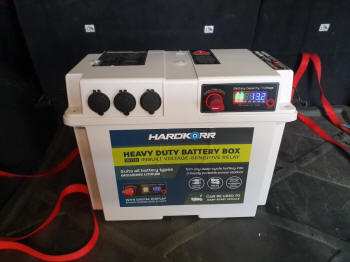 |
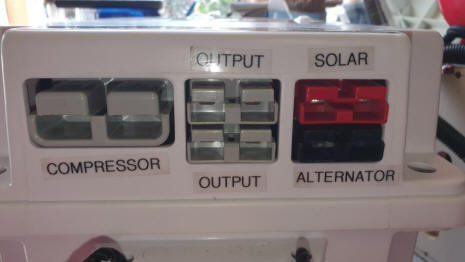 |
|
the battery box |
Anderson plugs on end of battery box |
|
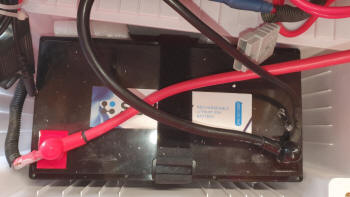 |
 |
|
battery sitting inside the box |
underside of the battery box lid |
|
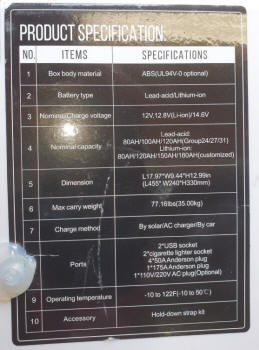 |
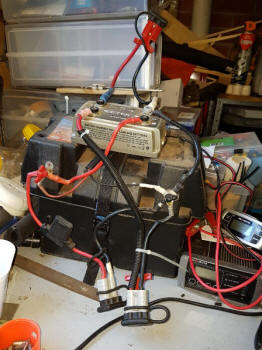 |
|
battery box specifications |
old battery box setup |
air
compressor
The compressor is a twin
cylinder Thumper Max from the 4WD Supercentre with a 300 litre
per minute rating. The previous air compressor was a Bushranger
Max Air. They are chalk and cheese. The Bushranger would take a
few minutes to pressurise the air tank and 8 metre hose. The
Thumper does it in around 30 seconds.
I used a 150 amp
automotive relay to turn the compressor off and on from the
driver's seat – the compressor has a pressure limiting switch
built in, so it automatically turns itself off and on with
pressure changes, the limits being off at 125 psi and on at 90
psi. I simply have a run of speaker wire from the relay to a
switch by my right knee to activate it. To connect/disconnect
the switch cable to the relay I used a pair of Deans plugs, very
popular with remote control aircraft people. It is rated to 60
amps so should handle the switching current, that way I can turn
it on and off from the driver’s seat and not have to access the
compressor’s own switch. I store the hose coiled up in a canvas
bag which I can either leave on top of the load in the back or
attach to the rear headrest and hang on the backseat backrest.
The 8 metres of hose easily reaches all the car and Crossover
tyres and I have an extra 4 metres that came with the compressor
and even has Nitto fittings to match my hose and fittings so I
can extend the hose to 12 metres and pump up other people's
tyres.
I have an 11 litre air
tank to maintain pressure in the system. It has an over
pressure release (150 psi), drain plug and pressure gauge
attached. A simple plywood casing I made up holds the compressor
and the air tank is bolted on top. The unit weighs in at 16
kilograms.
The wiring connected –
black 50 amp Anderson plug to the starter battery, grey 175 amp
Anderson plug to the compressor via the 150 Amp automotive
relay. The red Anderson plug is for unregulated solar and the
two spare grey Anderson plugs are for the fridge and anything
else I want to plug in.
The whole setup took
around a day to make up. It takes a few minutes to put it in
place and strap it all to the child seat restraints on the back
of the backseat. I only install it when needed so I am not
taking up space and carting 25 kilograms around when I don't
need it. The Lithium battery weighs less than half what the old
120 amp hour AGM weighed, has 60% more useable energy, charges
faster and maintains the Voltage down to 20% state of charge –
win, win, win and win.